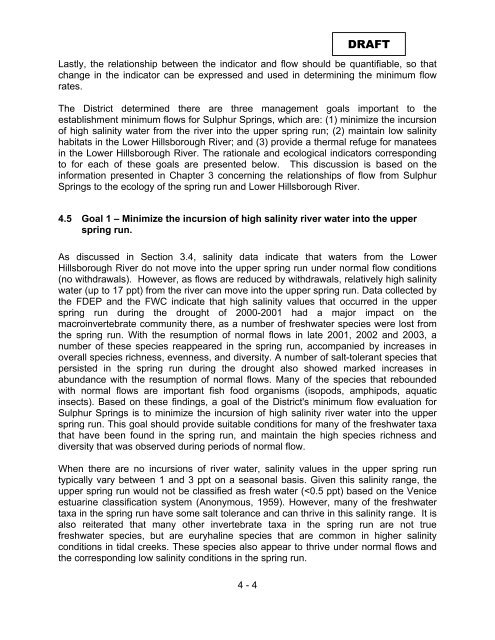The Determination of Minimum Flows for Sulphur Springs, Tampa
The Determination of Minimum Flows for Sulphur Springs, Tampa
The Determination of Minimum Flows for Sulphur Springs, Tampa
You also want an ePaper? Increase the reach of your titles
YUMPU automatically turns print PDFs into web optimized ePapers that Google loves.
DRAFT<br />
Lastly, the relationship between the indicator and flow should be quantifiable, so that<br />
change in the indicator can be expressed and used in determining the minimum flow<br />
rates.<br />
<strong>The</strong> District determined there are three management goals important to the<br />
establishment minimum flows <strong>for</strong> <strong>Sulphur</strong> <strong>Springs</strong>, which are: (1) minimize the incursion<br />
<strong>of</strong> high salinity water from the river into the upper spring run; (2) maintain low salinity<br />
habitats in the Lower Hillsborough River; and (3) provide a thermal refuge <strong>for</strong> manatees<br />
in the Lower Hillsborough River. <strong>The</strong> rationale and ecological indicators corresponding<br />
to <strong>for</strong> each <strong>of</strong> these goals are presented below. This discussion is based on the<br />
in<strong>for</strong>mation presented in Chapter 3 concerning the relationships <strong>of</strong> flow from <strong>Sulphur</strong><br />
<strong>Springs</strong> to the ecology <strong>of</strong> the spring run and Lower Hillsborough River.<br />
4.5 Goal 1 – Minimize the incursion <strong>of</strong> high salinity river water into the upper<br />
spring run.<br />
As discussed in Section 3.4, salinity data indicate that waters from the Lower<br />
Hillsborough River do not move into the upper spring run under normal flow conditions<br />
(no withdrawals). However, as flows are reduced by withdrawals, relatively high salinity<br />
water (up to 17 ppt) from the river can move into the upper spring run. Data collected by<br />
the FDEP and the FWC indicate that high salinity values that occurred in the upper<br />
spring run during the drought <strong>of</strong> 2000-2001 had a major impact on the<br />
macroinvertebrate community there, as a number <strong>of</strong> freshwater species were lost from<br />
the spring run. With the resumption <strong>of</strong> normal flows in late 2001, 2002 and 2003, a<br />
number <strong>of</strong> these species reappeared in the spring run, accompanied by increases in<br />
overall species richness, evenness, and diversity. A number <strong>of</strong> salt-tolerant species that<br />
persisted in the spring run during the drought also showed marked increases in<br />
abundance with the resumption <strong>of</strong> normal flows. Many <strong>of</strong> the species that rebounded<br />
with normal flows are important fish food organisms (isopods, amphipods, aquatic<br />
insects). Based on these findings, a goal <strong>of</strong> the District's minimum flow evaluation <strong>for</strong><br />
<strong>Sulphur</strong> <strong>Springs</strong> is to minimize the incursion <strong>of</strong> high salinity river water into the upper<br />
spring run. This goal should provide suitable conditions <strong>for</strong> many <strong>of</strong> the freshwater taxa<br />
that have been found in the spring run, and maintain the high species richness and<br />
diversity that was observed during periods <strong>of</strong> normal flow.<br />
When there are no incursions <strong>of</strong> river water, salinity values in the upper spring run<br />
typically vary between 1 and 3 ppt on a seasonal basis. Given this salinity range, the<br />
upper spring run would not be classified as fresh water (

















